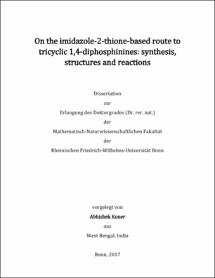Koner, Abhishek: On the imidazole-2-thione-based route to tricyclic 1,4-diphosphinines: synthesis, structures and reactions. - Bonn, 2018. - Dissertation, Rheinische Friedrich-Wilhelms-Universität Bonn.
Online-Ausgabe in bonndoc: https://nbn-resolving.org/urn:nbn:de:hbz:5n-49824
Online-Ausgabe in bonndoc: https://nbn-resolving.org/urn:nbn:de:hbz:5n-49824
@phdthesis{handle:20.500.11811/7505,
urn: https://nbn-resolving.org/urn:nbn:de:hbz:5n-49824,
author = {{Abhishek Koner}},
title = {On the imidazole-2-thione-based route to tricyclic 1,4-diphosphinines: synthesis, structures and reactions},
school = {Rheinische Friedrich-Wilhelms-Universität Bonn},
year = 2018,
month = feb,
note = {The PhD Thesis “On the imidazole-2-thione-based route to tricyclic 1,4-diphosphinines: synthesis, structures and reactions” describes the synthetic concept to and first studies on the chemistry of novel tricyclic 1,4-dihydro-1,4-diphosphinines and 1,4-diphosphinines.
In the first part, synthesis of the major starting material, the (Et2N)2P- and Et2N(Cl)P-substituted imidazole-2-thiones is described. The latter was converted into tricyclic 1,4-dihydro-1,4-diphosphinines via an LDA-induced double salt metathesis. Further studies on Et2N(Cl)P-substituted imidazole-2-thiones focused on backbone phosphaalkenyl substituted imidazole-2-thiones and/or imidazole-2-ylidenes.
The chemistry of tricyclic 1,4-dihydro-1,4-diphosphinines were explored in various directions ranging from P-oxidation to P-functionalization and competing P/S-centered reactions with electrophiles; the latter was accompanied by theoretical studies (A. Frontera). Furthermore, reduction of 1,4-dichloro-1,4-dihydro-1,4-diphosphinines with a mild reducing agent enabled access to first examples of isolated stable, red 1,4-diphos-phinines which are very sensible towards moist air. The 1,4-diphosphinines were fully characterized including cyclic voltammetry (CV) and UV/vis measurements as well as theoretical bonding analysis (L. Nyulaszi). Among the remarkable results are a reversible 3e-reduction (CV) and that the LUMO is largely concentrated on the phosphorus centers. The latter explains why anionic nucleophiles add to the phosphorus centers in a 1,4-fashion to produce anionic phosphanido centers which can be quenched with electrophiles. Further investigations revealed that 1,4-diphosphinines are excellent dienophiles in [4+2] reactions including a wide variety of C-C and N-N p-systems, but also s-bonds as in diphenyl dichalcogenides (E = S, Se). The latter reactions led exclusively to trans products which was explained on the basis of DFT calculations as a sequence of 1,4-addition followed by P-inversion (L. Nyulaszi).},
url = {https://hdl.handle.net/20.500.11811/7505}
}
urn: https://nbn-resolving.org/urn:nbn:de:hbz:5n-49824,
author = {{Abhishek Koner}},
title = {On the imidazole-2-thione-based route to tricyclic 1,4-diphosphinines: synthesis, structures and reactions},
school = {Rheinische Friedrich-Wilhelms-Universität Bonn},
year = 2018,
month = feb,
note = {The PhD Thesis “On the imidazole-2-thione-based route to tricyclic 1,4-diphosphinines: synthesis, structures and reactions” describes the synthetic concept to and first studies on the chemistry of novel tricyclic 1,4-dihydro-1,4-diphosphinines and 1,4-diphosphinines.
In the first part, synthesis of the major starting material, the (Et2N)2P- and Et2N(Cl)P-substituted imidazole-2-thiones is described. The latter was converted into tricyclic 1,4-dihydro-1,4-diphosphinines via an LDA-induced double salt metathesis. Further studies on Et2N(Cl)P-substituted imidazole-2-thiones focused on backbone phosphaalkenyl substituted imidazole-2-thiones and/or imidazole-2-ylidenes.
The chemistry of tricyclic 1,4-dihydro-1,4-diphosphinines were explored in various directions ranging from P-oxidation to P-functionalization and competing P/S-centered reactions with electrophiles; the latter was accompanied by theoretical studies (A. Frontera). Furthermore, reduction of 1,4-dichloro-1,4-dihydro-1,4-diphosphinines with a mild reducing agent enabled access to first examples of isolated stable, red 1,4-diphos-phinines which are very sensible towards moist air. The 1,4-diphosphinines were fully characterized including cyclic voltammetry (CV) and UV/vis measurements as well as theoretical bonding analysis (L. Nyulaszi). Among the remarkable results are a reversible 3e-reduction (CV) and that the LUMO is largely concentrated on the phosphorus centers. The latter explains why anionic nucleophiles add to the phosphorus centers in a 1,4-fashion to produce anionic phosphanido centers which can be quenched with electrophiles. Further investigations revealed that 1,4-diphosphinines are excellent dienophiles in [4+2] reactions including a wide variety of C-C and N-N p-systems, but also s-bonds as in diphenyl dichalcogenides (E = S, Se). The latter reactions led exclusively to trans products which was explained on the basis of DFT calculations as a sequence of 1,4-addition followed by P-inversion (L. Nyulaszi).},
url = {https://hdl.handle.net/20.500.11811/7505}
}






